当前位置:网站首页>【RT-Thread】nxp rt10xx 设备驱动框架之--Pin搭建和使用
【RT-Thread】nxp rt10xx 设备驱动框架之--Pin搭建和使用
2022-07-03 17:07:00 【L_17】
开发前准备
- 硬件平台:nxp rt10xx单片机
- IDE: Keil
1.Kconfig 修改和menuconfig配置
Kconfig中发现PIN 配置默认是选中状态(毕竟最常用的IO驱动设备)
RT-Thread Comonents -> Device Drivers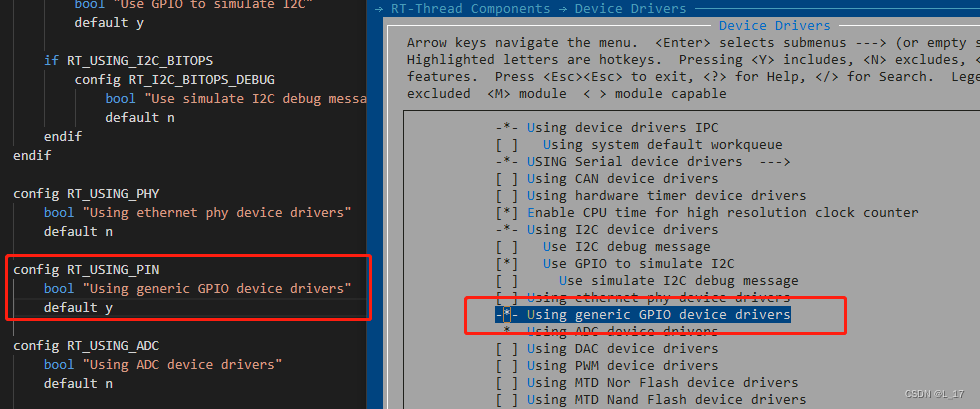
RT-Thread Components-> On-chip Peripheral Drivers
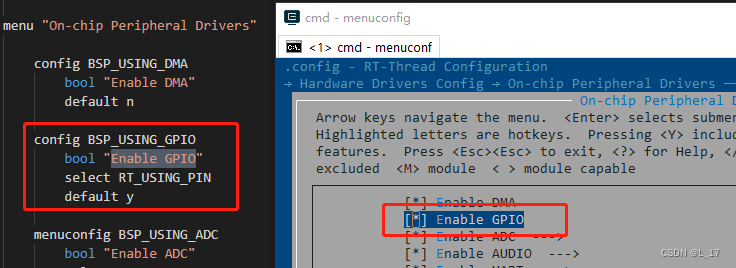
2.工程添加PIN驱动框架和BSP驱动接口
设备驱动框架:pin.c BSP接口:drv_gpio.c fsl_gpio.c fsl_iomuxc.c

3.添加或修改drv_gpio.c
笔者查阅了文件,该驱动很完善,几乎不用改什么,接下来先了解下基本框架吧
struct rt_pin_ops
{
void (*pin_mode)(struct rt_device *device, rt_base_t pin, rt_base_t mode);
void (*pin_write)(struct rt_device *device, rt_base_t pin, rt_base_t value);
int (*pin_read)(struct rt_device *device, rt_base_t pin);
rt_err_t (*pin_attach_irq)(struct rt_device *device, rt_int32_t pin,
rt_uint32_t mode, void (*hdr)(void *args), void *args);
rt_err_t (*pin_detach_irq)(struct rt_device *device, rt_int32_t pin);
rt_err_t (*pin_irq_enable)(struct rt_device *device, rt_base_t pin, rt_uint32_t enabled);
rt_base_t (*pin_get)(const char *name);
};
const static struct rt_pin_ops imxrt_pin_ops =
{
imxrt_pin_mode,
imxrt_pin_write,
imxrt_pin_read,
imxrt_pin_attach_irq,
imxrt_pin_detach_irq,
imxrt_pin_irq_enable,
RT_NULL,
};
int rt_hw_pin_init(void)
{
int ret = RT_EOK;
ret = rt_device_pin_register("pin", &imxrt_pin_ops, RT_NULL);
return ret;
}
INIT_BOARD_EXPORT(rt_hw_pin_init);
该bsp基本很完善了,没什么要改的,简单展示一下吧
static void imxrt_isr(rt_int16_t index_offset, rt_int8_t pin_start, GPIO_Type *base)
{
rt_int32_t isr_status, index;
rt_int8_t i, pin_end;
pin_end = pin_start + 15;
isr_status = GPIO_PortGetInterruptFlags(base) & base->IMR;
for (i = pin_start; i <= pin_end ; i++)
{
if (isr_status & (1 << i))
{
GPIO_PortClearInterruptFlags(base, (1 << i));
index = index_offset + i;
if (hdr_tab[index].hdr != RT_NULL)
{
hdr_tab[index].hdr(hdr_tab[index].args);
}
}
}
}
static void imxrt_pin_mode(rt_device_t dev, rt_base_t pin, rt_base_t mode)
{
gpio_pin_config_t gpio;
rt_uint32_t config_value = 0;
rt_int8_t port, pin_num;
port = pin >> 5;
pin_num = pin & 31;
if (PIN_INVALID_CHECK(port, pin_num))
{
LOG_D("invalid pin,rtt pin: %d,port: %d,pin: %d \n", pin,port + 1,pin_num);
return;
}
gpio.outputLogic = 0;
gpio.interruptMode = kGPIO_NoIntmode;
switch (mode)
{
case PIN_MODE_OUTPUT:
{
gpio.direction = kGPIO_DigitalOutput;
config_value = 0x0030U; /* Drive Strength R0/6 */
}
break;
case PIN_MODE_INPUT:
{
gpio.direction = kGPIO_DigitalInput;
config_value = 0x0830U; /* Open Drain Enable */
}
break;
case PIN_MODE_INPUT_PULLDOWN:
{
gpio.direction = kGPIO_DigitalInput;
config_value = 0x3030U; /* 100K Ohm Pull Down */
}
break;
case PIN_MODE_INPUT_PULLUP:
{
gpio.direction = kGPIO_DigitalInput;
config_value = 0xB030U; /* 100K Ohm Pull Up */
}
break;
case PIN_MODE_OUTPUT_OD:
{
gpio.direction = kGPIO_DigitalOutput;
config_value = 0x0830U; /* Open Drain Enable */
}
break;
}
if (mask_tab[port].gpio != GPIO5)
{
CLOCK_EnableClock(kCLOCK_Iomuxc);
IOMUXC_SetPinMux(MUX_BASE + reg_offset[pin] * 4, 0x5U, 0, 0, CONFIG_BASE + reg_offset[pin] * 4, 1);
IOMUXC_SetPinConfig(MUX_BASE + reg_offset[pin] * 4, 0x5U, 0, 0, CONFIG_BASE + reg_offset[pin] * 4, config_value);
}
else
{
CLOCK_EnableClock(kCLOCK_IomuxcSnvs);
IOMUXC_SetPinMux(GPIO5_MUX_BASE + pin_num * 4, 0x5U, 0, 0, GPIO5_CONFIG_BASE + pin_num * 4, 1);
IOMUXC_SetPinConfig(GPIO5_MUX_BASE + pin_num * 4, 0x5U, 0, 0, GPIO5_CONFIG_BASE + pin_num * 4, config_value);
}
GPIO_PinInit(mask_tab[port].gpio, pin_num, &gpio);
}
static int imxrt_pin_read(rt_device_t dev, rt_base_t pin)
{
int value;
rt_int8_t port, pin_num;
value = PIN_LOW;
port = pin >> 5;
pin_num = pin & 31;
if (PIN_INVALID_CHECK(port, pin_num))
{
LOG_D("invalid pin,rtt pin: %d,port: %d,pin: %d \n", pin,port + 1,pin_num);
return value;
}
return GPIO_PinReadPadStatus(mask_tab[port].gpio, pin_num);
}
static void imxrt_pin_write(rt_device_t dev, rt_base_t pin, rt_base_t value)
{
rt_int8_t port, pin_num;
port = pin >> 5;
pin_num = pin & 31;
if (PIN_INVALID_CHECK(port, pin_num))
{
LOG_D("invalid pin,rtt pin: %d,port: %d,pin: %d \n", pin,port + 1,pin_num);
return;
}
GPIO_PinWrite(mask_tab[port].gpio, pin_num, value);
}
static rt_err_t imxrt_pin_attach_irq(struct rt_device *device, rt_int32_t pin,
rt_uint32_t mode, void (*hdr)(void *args), void *args)
{
rt_base_t level;
rt_int8_t port, pin_num;
port = pin >> 5;
pin_num = pin & 31;
if (PIN_INVALID_CHECK(port, pin_num))
{
LOG_D("invalid pin,rtt pin: %d,port: %d,pin: %d \n", pin,port + 1,pin_num);
return RT_ENOSYS;
}
level = rt_hw_interrupt_disable();
if (hdr_tab[pin].pin == pin &&
hdr_tab[pin].hdr == hdr &&
hdr_tab[pin].mode == mode &&
hdr_tab[pin].args == args)
{
rt_hw_interrupt_enable(level);
return RT_EOK;
}
hdr_tab[pin].pin = pin;
hdr_tab[pin].hdr = hdr;
hdr_tab[pin].mode = mode;
hdr_tab[pin].args = args;
rt_hw_interrupt_enable(level);
return RT_EOK;
}
static rt_err_t imxrt_pin_detach_irq(struct rt_device *device, rt_int32_t pin)
{
rt_base_t level;
rt_int8_t port, pin_num;
port = pin >> 5;
pin_num = pin & 31;
if (PIN_INVALID_CHECK(port, pin_num))
{
LOG_D("invalid pin,rtt pin: %d,port: %d,pin: %d \n", pin,port + 1,pin_num);
return RT_ENOSYS;
}
level = rt_hw_interrupt_disable();
if (hdr_tab[pin].pin == -1)
{
rt_hw_interrupt_enable(level);
return RT_EOK;
}
hdr_tab[pin].pin = -1;
hdr_tab[pin].hdr = RT_NULL;
hdr_tab[pin].mode = 0;
hdr_tab[pin].args = RT_NULL;
rt_hw_interrupt_enable(level);
return RT_EOK;
}
static rt_err_t imxrt_pin_irq_enable(struct rt_device *device, rt_base_t pin, rt_uint32_t enabled)
{
gpio_interrupt_mode_t int_mode;
rt_int8_t port, pin_num, irq_index;
port = pin >> 5;
pin_num = pin & 31;
if (PIN_INVALID_CHECK(port, pin_num))
{
LOG_D("invalid pin,rtt pin: %d,port: %d,pin: %d \n", pin,port + 1,pin_num);
return RT_ENOSYS;
}
if (hdr_tab[pin].pin == -1)
{
LOG_D("rtt pin: %d callback function not initialized!\n", pin);
return RT_ENOSYS;
}
if (enabled == PIN_IRQ_ENABLE)
{
switch (hdr_tab[pin].mode)
{
case PIN_IRQ_MODE_RISING:
int_mode = kGPIO_IntRisingEdge;
break;
case PIN_IRQ_MODE_FALLING:
int_mode = kGPIO_IntFallingEdge;
break;
case PIN_IRQ_MODE_RISING_FALLING:
int_mode = kGPIO_IntRisingOrFallingEdge;
break;
case PIN_IRQ_MODE_HIGH_LEVEL:
int_mode = kGPIO_IntHighLevel;
break;
case PIN_IRQ_MODE_LOW_LEVEL:
int_mode = kGPIO_IntLowLevel;
break;
default:
int_mode = kGPIO_IntRisingEdge;
break;
}
irq_index = (port << 1) + (pin_num >> 4);
GPIO_PinSetInterruptConfig(mask_tab[port].gpio, pin_num, int_mode);
GPIO_PortEnableInterrupts(mask_tab[port].gpio, 1U << pin_num);
NVIC_SetPriority(irq_tab[irq_index], NVIC_EncodePriority(NVIC_GetPriorityGrouping(), 5, 0));
EnableIRQ(irq_tab[irq_index]);
}
else if (enabled == PIN_IRQ_DISABLE)
{
GPIO_PortDisableInterrupts(mask_tab[port].gpio, 1U << pin_num);
}
else
{
return RT_EINVAL;
}
return RT_EOK;
}
4.搭建应用层demo
基本功能LED0线程中闪烁,LED1通过KEY0按一次翻转一次IO
/**************************************************START OF FILE*****************************************************/
/*------------------------------------------------------------------------------------------------------------------ Includes */
#include <rtthread.h>
#include <rtdevice.h>
#include "drv_gpio.h"
/*------------------------------------------------------------------------------------------------------------------ Macros */
#define THREAD_GPIO_PRIORITY 24
#define THREAD_GPIO_STACK_SIZE 512
#define THREAD_GPIO_TIMESLICE 2
#define LED0_PIN GET_PIN(1, 9)
#define LED1_PIN GET_PIN(1, 24)
#define KEY0_PIN GET_PIN(5, 0) //IOMUXC_SNVS_WAKEUP_GPIO5_IO00
/*------------------------------------------------------------------------------------------------------------------ Variables */
static rt_thread_t h_thread_gpio = RT_NULL;
static uint8_t ledBlink;
/*------------------------------------------------------------------------------------------------------------------ Functions */
/* 中断回调函数 */
void key_irq(void *args)
{
rt_kprintf("key push!\n");
rt_pin_write(LED1_PIN, !rt_pin_read(LED1_PIN));
}
static void thread_gpio(void *parameter)
{
rt_kprintf("thread gpio start\n");
while(1)
{
rt_pin_write(LED0_PIN, PIN_HIGH);
// rt_pin_write(LED1_PIN, PIN_HIGH);
rt_thread_mdelay(500);
rt_pin_write(LED0_PIN, PIN_LOW);
// rt_pin_write(LED1_PIN, PIN_LOW);
rt_thread_mdelay(500);
}
}
void xAPP_GpioInit(void)
{
rt_pin_mode(LED0_PIN, PIN_MODE_OUTPUT);
rt_pin_mode(LED1_PIN, PIN_MODE_OUTPUT);
rt_pin_write(LED1_PIN, PIN_HIGH);
rt_pin_mode(KEY0_PIN, PIN_MODE_INPUT_PULLUP);
rt_pin_attach_irq(KEY0_PIN, PIN_IRQ_MODE_FALLING, key_irq, RT_NULL);
rt_pin_irq_enable(KEY0_PIN, PIN_IRQ_ENABLE);
//创建Audio线程
h_thread_gpio = rt_thread_create("t_gpio",thread_gpio,RT_NULL,THREAD_GPIO_STACK_SIZE,THREAD_GPIO_PRIORITY,THREAD_GPIO_TIMESLICE);
if (h_thread_gpio != RT_NULL)
{
rt_thread_startup(h_thread_gpio);
}
}
/****************************************************END OF FILE*****************************************************/
测试结果
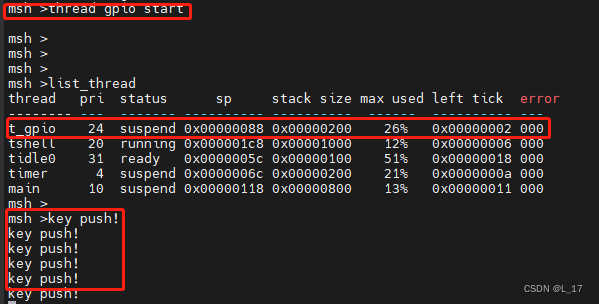
边栏推荐
- Svn full backup svnadmin hotcopy
- Kotlin学习快速入门(7)——扩展的妙用
- The most complete postman interface test tutorial in the whole network, API interface test
- Static program analysis (I) -- Outline mind map and content introduction
- One brush 145 force deduction hot question-2 sum of two numbers (m)
- Pools de Threads: les composants les plus courants et les plus sujets aux erreurs du Code d'affaires
- [mathematical logic] equivalent calculus and reasoning calculus of propositional logic (propositional logic | equivalent calculus | principal conjunctive (disjunctive) paradigm | reasoning calculus)**
- Mysql database DDL and DML
- How SVN views modified file records
- Thread pool: the most common and error prone component of business code
猜你喜欢

What is the material of 13mnnimor? 13mnnimor steel plate for medium and low temperature pressure vessels
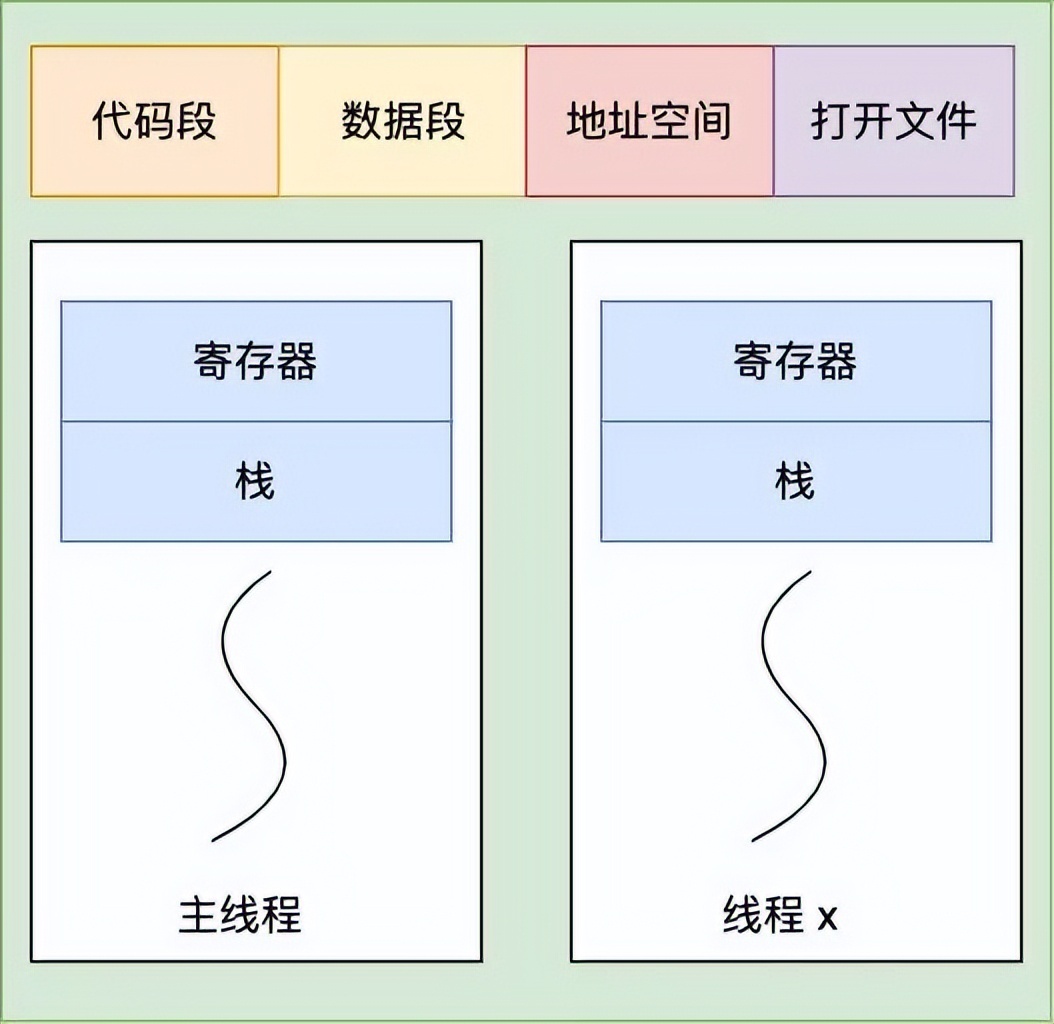
Meituan side: why does thread crash not cause JVM crash
![[combinatorics] polynomial theorem (polynomial theorem | polynomial theorem proof | polynomial theorem inference 1 item number is the number of non negative integer solutions | polynomial theorem infe](/img/9d/6118b699c0d90810638f9b08d4f80a.jpg)
[combinatorics] polynomial theorem (polynomial theorem | polynomial theorem proof | polynomial theorem inference 1 item number is the number of non negative integer solutions | polynomial theorem infe
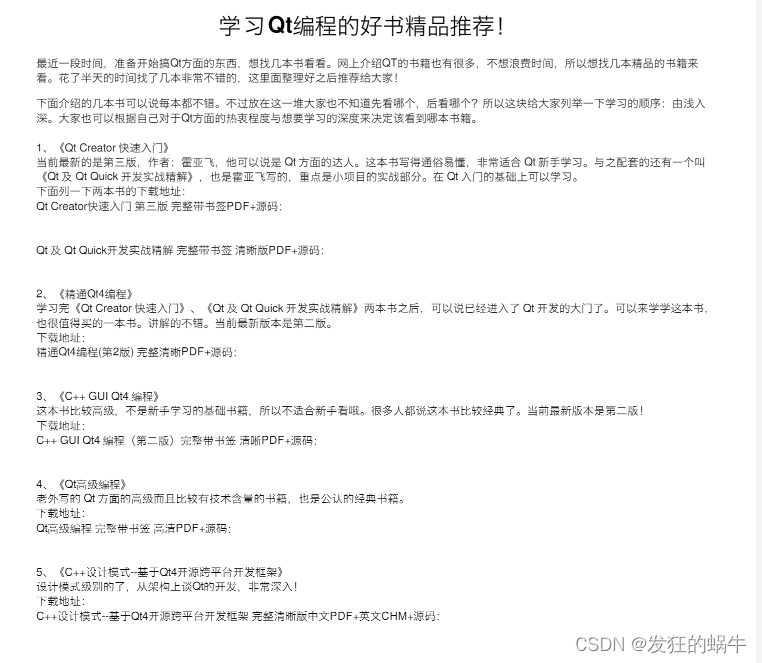
Recommendation of good books on learning QT programming

The most complete postman interface test tutorial in the whole network, API interface test

大消费企业怎样做数字化转型?

Free data | new library online | cnopendata complete data of China's insurance intermediary outlets
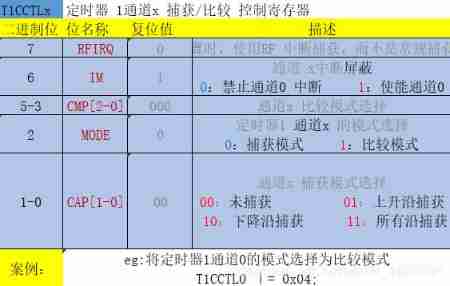
CC2530 common registers for timer 1

Fast Ethernet and Gigabit Ethernet: what's the difference?

图之深度优先搜索
随机推荐
mysql用户管理
定义一个结构体Fraction,表示分数,用于表示 2/3, 5/6这样的分数
C language string inversion
Capacités nécessaires à l'analyse des données
Informatics Olympiad all in one YBT 1175: divide by 13 | openjudge noi 1.13 27: divide by 13
Bcvp developer community 2022 exclusive peripheral first bullet
Fast Ethernet and Gigabit Ethernet: what's the difference?
How to promote cross department project collaboration | community essay solicitation
One brush 148 force deduction hot question-5 longest palindrome substring (m)
手把手带你入门 API 开发
Life is still confused? Maybe these subscription numbers have the answers you need!
Simple configuration of postfix server
What is your income level in the country?
图之深度优先搜索
function overloading
简单配置PostFix服务器
Daily code 300 lines learning notes day 10
Interpretation of several important concepts of satellite antenna
浅谈拉格朗日插值及其应用
Mysql database -dql